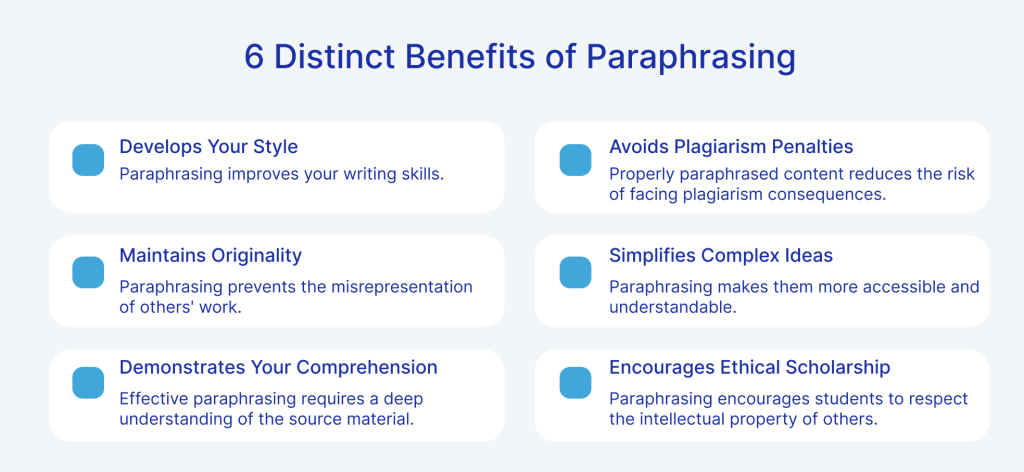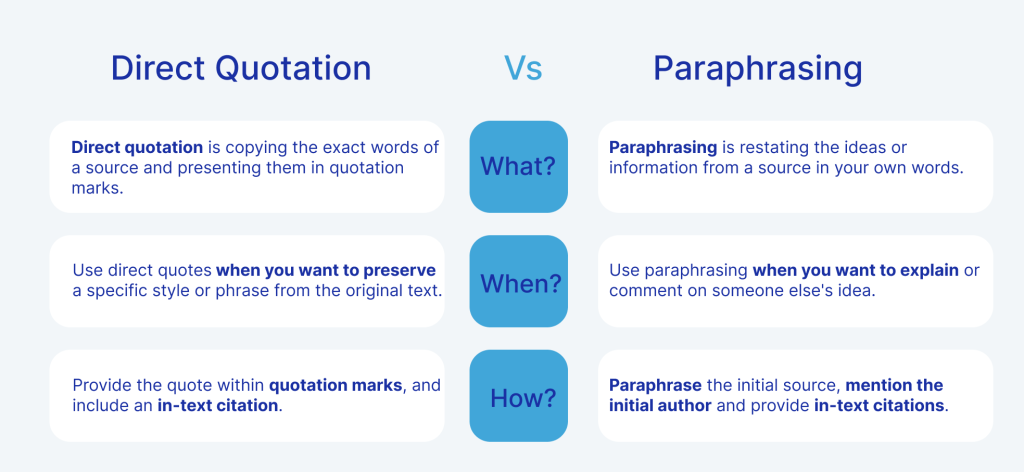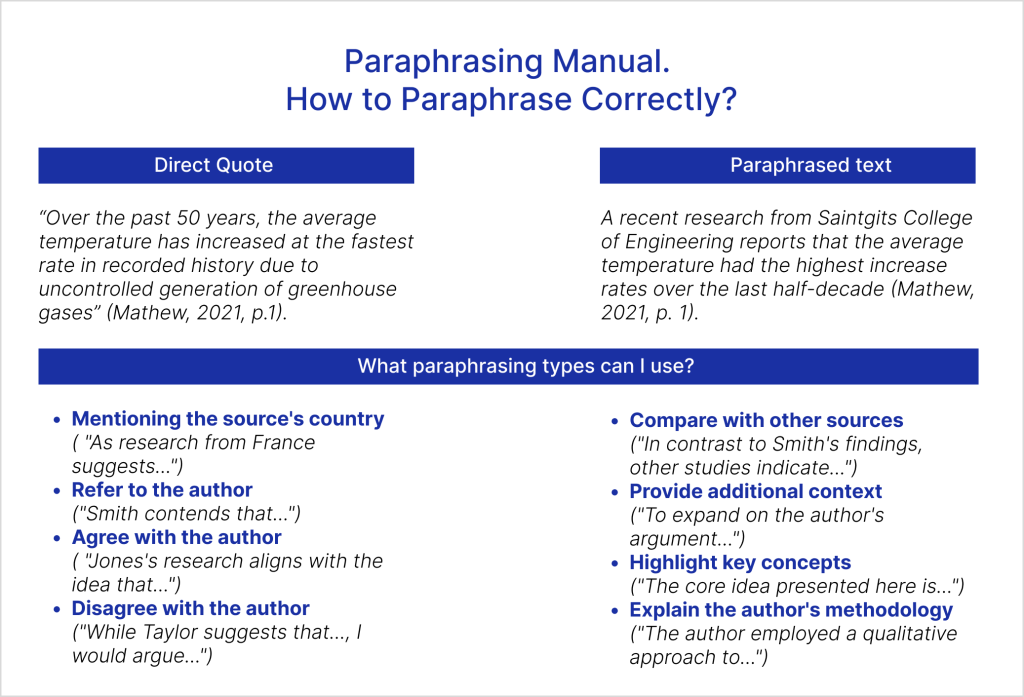People cannot know everything, which explains why students may face challenges when writing papers on specific topics. However, searching and analyzing various sources can help them gain the necessary knowledge and accomplish all assignments. Paraphrasing is integral to the writing process because it allows students to write papers about multiple issues, even if they lack the knowledge to answer particular questions. Let’s focus on the importance of paraphrasing and some valuable tips to help you paraphrase your sources correctly.
What Is Paraphrasing in Academic Writing?
Paraphrasing means restating the ideas found in a specific source using different words. Specifically, the information you have obtained from various sources should be put in your own wordswhen paraphrasing to prevent plagiarism and make your statement clear to readers. Most universities use a plagiarism checker to monitor whether students avoid plagiarism and attribution of others’ scientific achievements since academic integrity is recognized as one of their primary values. Therefore, when you paraphrase you not only show respect for the established rules and another person’s efforts but also improve your understanding of the topic you are writing about.
Can Paraphrasing Prevent Plagiarism?
Yes, it can. The main goal of paraphrasing is plagiarism avoidance: rewriting in your own words makes a plagiarismchecker unable to determine the source you have used to write your paper. However, it’s essential to change the structure of the text, use synonyms instead of the originalwords used in the source, and focus on your own writing style when paraphrasing.
You also need to check whether key terms have not been changed to retain the original ideas of the source. Incorrect paraphrasing frequently leads to a high plagiarism index, proving that a teacher’s task is to encourage students to try to learn how to paraphrase sources properly. Learners should constantly use a plagiarism checker to monitor whether they submit an originalpaper.

How to Paraphrase Sources?
Paraphrasing means putting the ideas and information you have found in various sources in your own words. Specifically, paraphrasing is when you explore a source, analyze its key findings, and explain this information using different words and sentence structures. If you want to understand how to paraphrase a paragraph properly, you need to analyze the original source thoroughly to understand its meaning, identify its critical ideas without rereading the article or book (writing down the key issues can help in this process), and check whether the words and sentence structure in your paper differ from the source.
Although you cannot change critical words when paraphrasing, using synonyms instead of phrases with a supporting role is integral to paraphrasing. Changed structure of the text, changed length of a sentence, and changed order of sentences within the text play a vital role in paraphrasing sources, proving that universities should encourage students to try to learn how to rephrase a sentence, paragraph, or entire article correctly to prevent plagiarism and make the text clear, coherent, and logical. Here is a simple example:
| Original text | Paraphrasing |
Commentary |
| “Japan today enjoys one of the highest standards of living of any nation” (Flath, 2022, p.2) | Professor of North Carolina State University David Flath believes that Japan nowadays is one of the best countries considering the quality of life (2022). | The paraphrased sentence has a different structure, slightly differs in the main idea, and uses different phrasing. |
How to Cite a Paraphrase?
Although paraphrasing means putting specific information you have found in different sources in your own words, it’s important to cite these parts to show that you respect academic integrity and other authors’ efforts and contributions. If you need to understand how to cite a paraphrase properly, consider the paper format specified in the instructions. MLA and APA are the most popular formats most universities use, so let’s focus on citations using these two formats.
If the instructions require using MLA format, specify the author’s name and the page number where you have found the necessary information in parentheses. APA format requires indicating the author’s name, year of publication, and the page number where the essential information has been found. Notably, in APA format, the page number should be specified only in case of direct quotation. Check the following examples of citing a paraphrase:
- MLA format: People who avoid caring for their mental health face stress, anxiety, and depression (White 58).
- APA format: Stress and anxiety are the primary mental health challenges most students face today (Brown, 2022).
Not only paraphrasing but also direct quotation can be used if you realize that the sentence or a specific text cannot be paraphrased or changed. Check the examples below to understand the difference between paraphrasing and direct quotation:
- MLA format: White states: “Stress, anxiety, and depression result from a lack of adequate mental health care” (58).
- APA format: Brown et al. explain that “38% of students worldwide have mental health challenges, including stress and anxiety” (2022, p. 107).
Citations play a vital role in academic papers because they demonstrate that students have researched their topic and support their ideas using credible sources. Moreover, citation allows students to give credit to the authors whose works they have used when paraphrasing.
Plagiarism and attribution frequently result from inappropriate paraphrasing, a lack of citations, and students’ decisions not to use a plagiarism checker before submitting their text. Therefore, always cite each source you are using in your writing; don’t forget to complete a plagiarism check to prevent plagiarism and attribution and submit an original text that meets academic requirements.

Paraphrasing Tool Online Free
Modern students frequently use AI and various free online paraphrasing tools to simplify the writing process. Undoubtedly, you can utilize AI to speed up the overall progress and check possible examples of paraphrasing. However, many students face plagiarism when using such apps and tools, proving that it’s important to paraphrase the text provided by AI and always complete a plagiarism check before submitting the paper to the university platform. Universities should motivate students to try to learn how to paraphrase properly and require them to use a plagiarism checker to prevent plagiarism and AI detection.
Examples of Paraphrasing
Check the text below and try to think how do you paraphrase the following sentence:
Gender discrimination means any exclusion or restriction made on the basis of gender that creates barriers for girls, boys, women, or men in recognizing, enjoying, or exercising their full and equal human rights.
Now let’s check possible examples of paraphrasing:
- Gender discrimination involves different kinds of exclusion or restriction based on gender that cause barriers for women, girls, men, or boys in respecting and fulfilling their equal human rights.
- Gender discrimination is one of the most severe global issues today that makes males and females unable to fulfill and protect their rights and freedoms. It results from the restrictions and rights violations based on human gender.
Try to suggest which is the best paraphrase of the passage. Undoubtedly, it’s better to use the second example of paraphrasing instead of the first one. The second option shows that key terms have not been changed, but synonyms have been used instead of the same words that play a supporting role; the sentence structure has also been transformed, proving that a plagiarism checker won’t highlight it as plagiarized.
Let’s focus on other examples of paraphrasing. For instance, paraphrase the following sentence: “Many vehicles require diesel to operate, adversely affecting the environment.” To avoid plagiarism, write: “Diesel-powered vehicles harm nature, proving the necessity of developing alternative fuel.” Be creative when paraphrasing, and don’t be afraid of making all the necessary changes to write an original paper.
How to Check Whether a Student Paraphrases Sentences Properly?
The overall paraphrase meaning is putting other authors’ ideas in your own words to demonstrate your understanding of the discussed issues and make a plagiarism checker show 0% of plagiarism. The following guide may help you monitor whether your paraphrasing examples are correct:
- You have transformed the sentence structure and replaced the words with synonyms, while key terms have not been changed.
- Plagiarism detection systems show 0% of plagiarism when you use the checker.
- Your sentences and passages differ from the ones in the original sources.
- Your text maintains the ideas from the original source while all the issues are discussed in your own words.
- You have checked the grammar within your text, and the paper seems smooth, logical, and coherent.
- You cite all the parts, including paraphrasing and direct quotations taken from sources.
A good way to check your paraphrasing is to read the original text and your version to someone and ask whether both sentences convey exactly the same idea. If the answer is yes, you have to add or change something in your rephrasing.
Useful Tips to Paraphrase Correctly
Paraphrasing source is a complex process that requires your time and attention. Remember that you need to read the original source several times before you are ready to paraphrase it properly. Try to paraphrase in five easy steps to write an original plagiarism–free paper that meets all the academic requirements.
- The first step includes reading the source several times to understand what the author is discussing.
- The second step requires the writer to determine the most crucial idea and try to summarize this idea in one sentence.
- The third step includes dividing the most important idea into several parts, which will help the writer to choose the most crucial points to discuss.
- Paraphrasing these ideas in your own words and phrases is the fourth step: focus on the synonyms, word order, sentence structure, and length to write a paper free of plagiarism.
- Cite all the essential sources within your text during the fifth step: check whether the ideas from your paper and the original source are similar and whether you have specified the author of these thoughts in your writing.
This approach will help you to paraphrase in five easy steps and submit a well-developed, high-quality essay.

Paraphrase in a sentence: what does it include?
If you paraphrase a sentence, explain its primary idea using different words, shorter or longer structures, and various word orders. It will help you prevent plagiarism and make your reader realize the primary purpose of your paper.
Remember how to paraphrase a quote to prevent plagiarism
Consider the question: Can you paraphrase a quote? Yes, you can use a direct quotation and explain the source’s idea using the same words or paraphrase it in your own words. However, citation is needed in both cases to avoid plagiarism and make your paper original.
Combine quotes and paraphrased text in your paper
Using too many quotes or paraphrasing in your text can make the paper difficult to understand, illogical, and less interesting. Your readers want to understand your opinion, so it’s better to focus on your thoughts but support them using credible sources.
Use citations to prevent showing an article as a plagiarized source
Always cite all the sources you are using to avoid plagiarism and submit an original paper that will help you receive the highest score. Most universities recognize plagiarism as one of the most severe forms of violation of academic integrity, so it’s better to follow the established conventions and avoid unnecessary issues.
Use a plagiarism checker to check the originality of your paper
Don’t forget to use a plagiarism checker to check your text for plagiarism to submit original writing.
Remember that correct paraphrasing makes your essay sound coherent and smooth
Try to consider all the factors when paraphrasing: word order, length of sentences, use of synonyms, proper word choice, clear ideas, and correct citation. Practice makes perfect! Improve your skills, and your paraphrasing achievements will soon impress everyone.